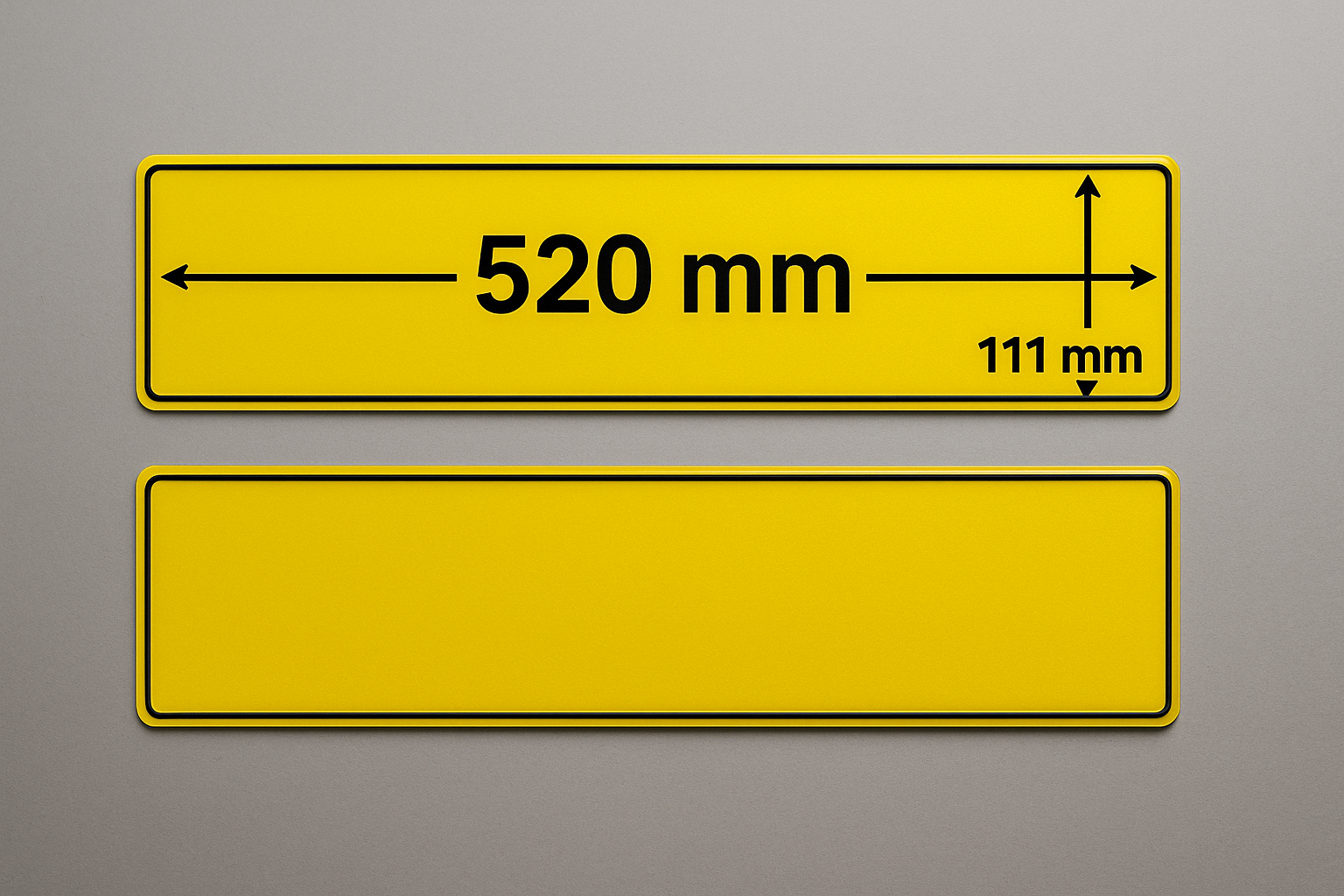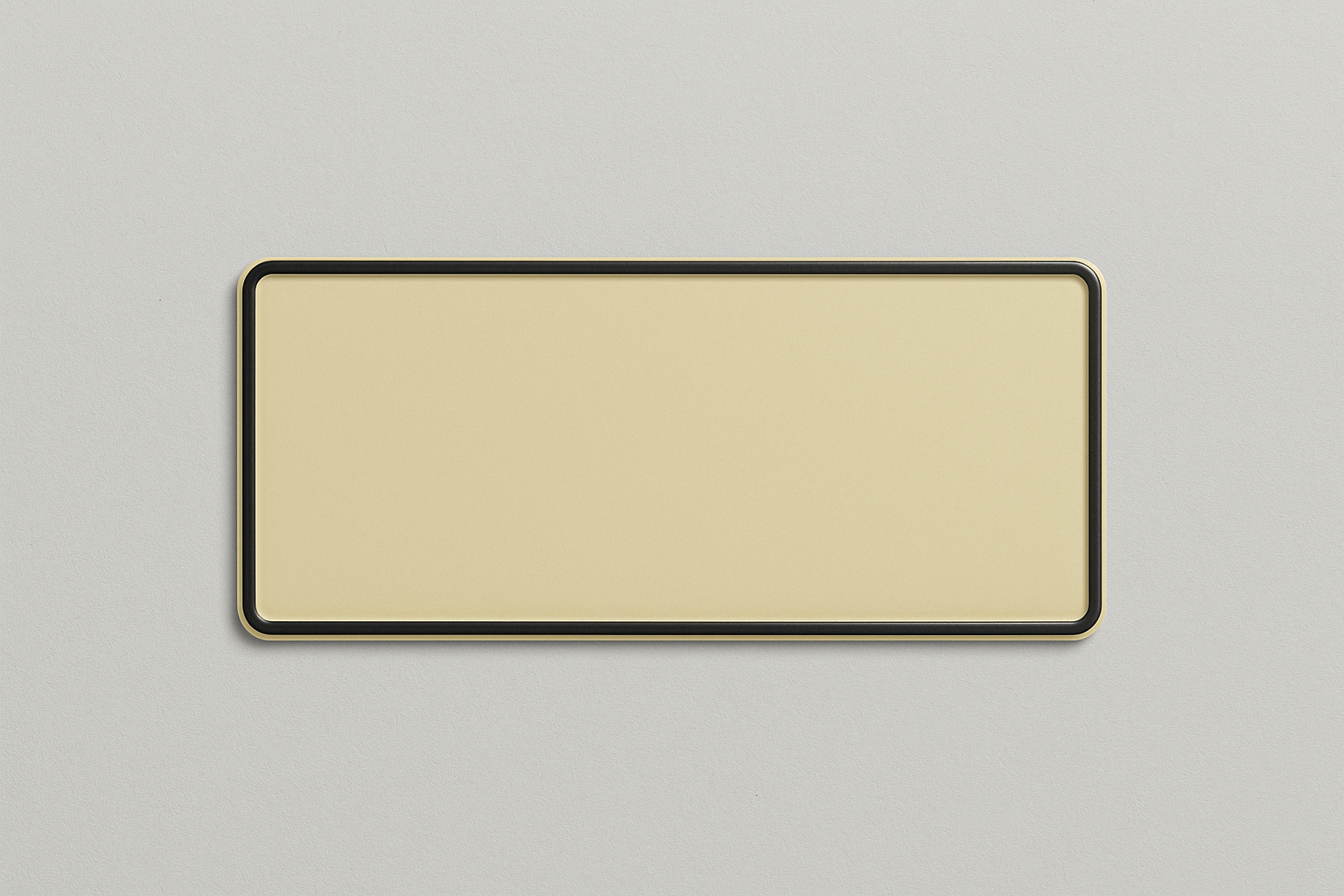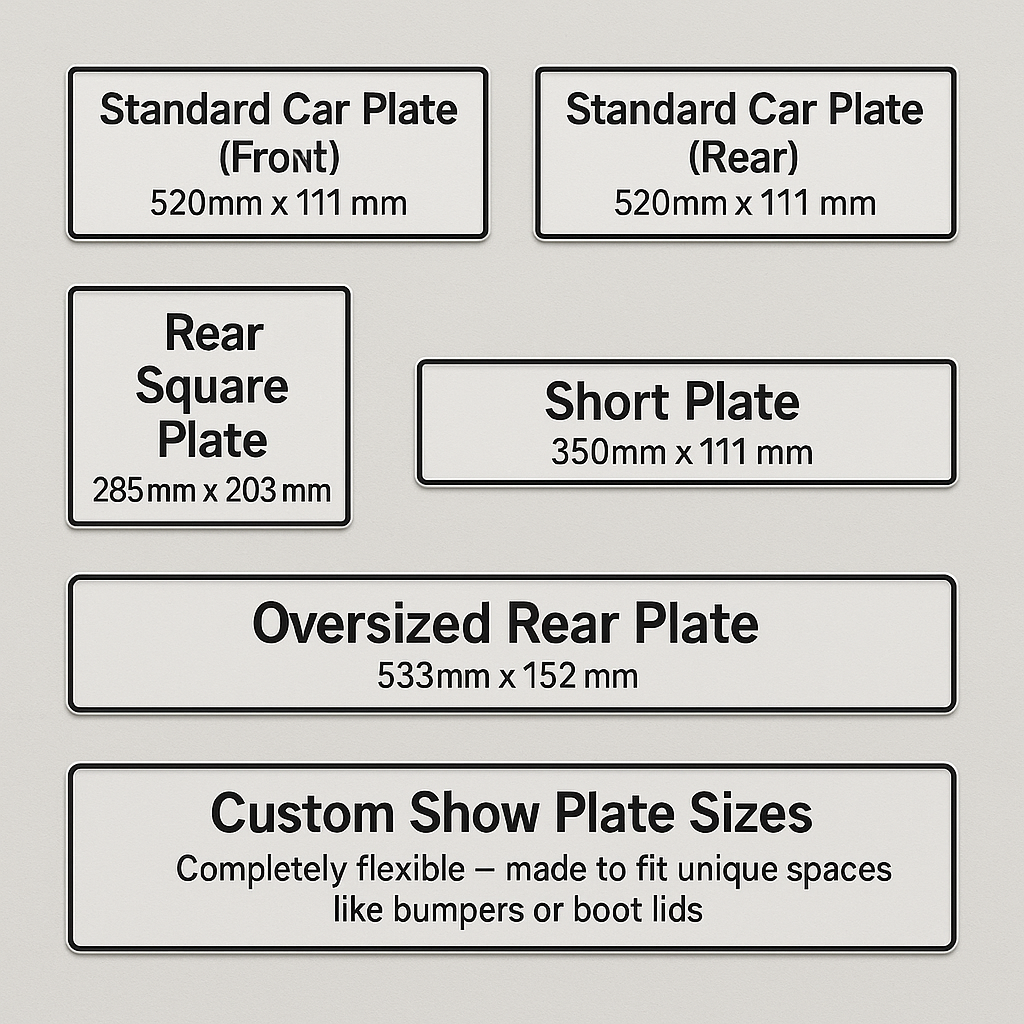So, picking the right number plate might not seem like the biggest decision you’ll make for your vehicle – yet it’s one that often gets overlooked until it’s too late. Too small, and it’s likely to land you in trouble. Too large, and it might look like it belongs on the wrong car entirely.
In the UK, number plate sizes aren’t just about aesthetics – they’re tied into legal requirements, visibility, and the type of vehicle you drive. Whether you’ve got a standard hatchback, a Japanese import, a café racer, or a completely custom ride, getting the plate size wrong can cause more hassle than you’d expect.
The truth is, there isn’t one size that fits every vehicle. Imports often need something shorter, bikes have their own rules altogether, and personal plates can sometimes benefit from a bit of tailoring – as long as you stay within the law.
That’s exactly why this guide exists. It's here to give you the information you actually need – no fluff, no jargon. Just a straightforward look at the most common plate sizes used in the UK, how they’re regulated, and where to get the right one.
By the end, you’ll know what fits, what’s legal, and where to buy with confidence.
Standard Number Plate Sizes for Cars

For most UK-registered vehicles, number plate sizes tend to follow a familiar pattern – mainly because that’s what fits the design of the car and keeps things road legal. The sizing’s often less about choice and more about what’s expected to sit neatly within the space provided by the manufacturer.
So, what do most cars actually use?
The typical size for standard number plates in the UK is:
- Front plate: 520mm x 111mm
- Rear plate (rectangular): 520mm x 111mm
- Rear plate (square – often seen on 4x4s and SUVs): 285mm x 203mm
Most drivers won’t give this much thought – and honestly, that’s kind of the point. These sizes are designed to slot straight into the recessed mounting points found on the vast majority of UK vehicles. No fiddling. No customisation. Just a straightforward fit.
The front plate, in particular, is almost always rectangular. That’s because vehicle fronts are built with aerodynamics, airflow, and symmetry in mind – and squeezing a square plate in there would throw the balance off completely.
At the rear, you sometimes have a bit more flexibility. Larger vehicles like Land Rovers or Mercedes G-Class often come with a square plate mount – it sits higher up and looks cleaner against the back door. Smaller hatchbacks, on the other hand, tend to follow the rectangle route.
So why do most people stick to standard plate sizing?
- It fits the vehicle as designed
- It’s easy to order and replace
- It avoids MOT issues or unwanted attention
- It keeps ANPR systems working correctly
There’s no legal requirement to use a square or rectangular rear plate – as long as the font, character spacing, and visibility meet DVLA standards. But the shape you pick should match what your car was built to carry. A plate that’s too small might not fill the space properly. One that’s too big might hang off the edges or look awkward.
In short? Stick with standard unless you’ve got a reason to switch – it’ll usually save you the hassle.
Import Vehicle Number Plate Sizes
If your car’s been imported – especially from places like Japan or the US – there’s a fair chance a standard UK number plate just won’t fit properly. The bumper might have a smaller recess, the lines of the car could feel off with a long rectangle, or the fitting points might make a standard plate look like an afterthought. That’s because many imports are built for different plate shapes entirely.
This is where import size number plates come in. They’re shorter, often squarer, and specifically made to sit neatly in the limited space available on non-UK vehicles. They’re not just a style preference – they’re often a necessity.
Here’s a quick snapshot of common import types and the plate sizes they typically need:
Vehicle Type | Typical Plate Size (mm) |
Japanese Imports (e.g. Toyota Supra, Nissan Silvia) | 330 x 165 |
Older Honda Imports (e.g. Civic EK9, Integra DC2) | 305 x 155 |
JDM Kei Cars (e.g. Suzuki Cappuccino, Daihatsu Hijet) | 280 x 152 |
American Imports (e.g. Ford Mustang, Chevy Camaro) | 305 x 152 |
These sizes are popular among drivers who want a tidy, factory-style finish. If you’ve ever seen a long UK plate overhanging the back of a Nissan Silvia, you’ll know exactly why a custom-sized plate makes such a difference.
So what does the law say?
You can use a smaller plate if the car physically requires it. The DVLA doesn’t insist on using the standard 520mm width for every car, because they understand imports weren’t built with UK sizing in mind. That said, the characters on the plate – their size, spacing, and font – still need to meet legal requirements.
Unless your plate setup looks suspiciously short or squeezed, you don’t usually need any special documentation or approval to fit an import-sized plate. In rare cases, you might be asked to provide evidence that the car can’t accommodate a standard plate – usually during an MOT or police stop. But as long as your plate is clear, reflective, and laid out properly, it won’t raise eyebrows.
So, if your imported car has a smaller plate recess, don’t try to force a full-size plate onto it. Go with the right fit, and the car will look better – and stay legal.
Motorcycle and Scooter Number Plate Sizes

For motorbikes and scooters, number plate sizing works a little differently than it does for cars – and not just because there’s less room to work with. There’s a legal minimum size that applies, and it’s there to make sure your reg is always visible, even from a distance.
The standard rear number plate size for most UK motorcycles is 190mm x 165mm. That’s about as small as it gets while still keeping within DVLA rules. You’ll often see variations that are a touch wider or taller depending on the bike’s rear space or layout, but that size is usually the benchmark.
And just to clear this up: motorbikes and scooters in the UK don’t need a front plate. In fact, fitting one isn’t allowed – so you’re only ever working with one plate, mounted at the back.
Now, while it’s tempting to go smaller for a cleaner, minimalist look (especially if you’re riding something like a café racer or a custom-built scrambler), anything below the legal character size could cause a problem. Plates that are too small, or that have squashed fonts and tight spacing, can land you with a fine or even an MOT failure.
Here’s what DVLA expects:
- Standard character height: 64mm
- Character width: 44mm (except for the digit “1” or letter “I”)
- Character stroke thickness: 10mm
- Horizontal spacing between characters: 10mm
- Vertical spacing between rows: 13mm
- Margins around the edge: 11mm
So even if the overall plate is smaller, the characters can’t be – that’s the bit that needs to stay legible.
For scooter riders especially, it’s worth checking the angle and visibility of the plate, too. If it’s tucked under a mudguard or angled too steeply, ANPR cameras might struggle to read it – and that’s another reason your bike could get flagged.
Legal Requirements for Number Plate Dimensions
Whether you’re driving something straight out of a showroom or tweaking a customised ride, number plate dimensions in the UK are more than just guidelines – they’re the law. It’s not just about making sure your reg looks tidy. It needs to be clearly readable by people, machines, and ANPR systems. So, if your plate doesn’t meet the DVLA’s specifications, you’re likely to run into trouble sooner or later.
Here’s what the DVLA sets out for most vehicles:
- Character height: 79mm
- Character width: 50mm (except for “1” or “I”)
- Stroke thickness: 14mm
- Horizontal spacing between characters: 11mm
- Space between character groups (e.g. AB and 12 CDE): 33mm
- Vertical spacing between lines (for stacked formats): 19mm
- Margins around the edges: Minimum 11mm
These measurements apply to standard number plates used on cars, vans, and 4x4s. Motorcycles and some imports are allowed slightly smaller characters, but they still follow similar layout principles – clarity and spacing are key.
Your plate must also:
- Use the Charles Wright typeface – no italics, squashed characters, or funky fonts.
- Have solid black lettering on a white background at the front and a yellow background at the rear
- Be made from reflective material that’s easy to read in poor light
- Include the name and postcode of the supplier, plus the BS AU 145e mark (which confirms it meets British Standards)
Now, the penalties for not sticking to these rules aren’t just technicalities. A plate that’s too small, hard to read, or missing required markings could land you with a £1,000 fine, cause an MOT failure, or trigger problems with things like toll roads and congestion zones where automatic number plate recognition (ANPR) is used.
Since September 2021, plates must meet BS AU 145e, which added stricter requirements around durability – including resistance to fading, bending, cracking, and impact damage. If your current plates are older and due for a replacement, it’s worth making sure the new ones meet this updated standard.
So, in short: the legal side isn’t something to guess at or eyeball. Get it right once, and you won’t have to think about it again.
Custom and Personalised Number Plate Sizes

Going for a private plate often opens up more than just a new reg – it gives drivers a bit of room to personalise the plate’s overall size, too. But while custom plates might look different, they still have to follow the same DVLA rules when it comes to what’s printed on them.
Let’s say you’ve got a short registration – something like “J4 MES” or “R9 LLY”. There’s no reason to stretch that across a standard 520mm plate if it ends up with loads of empty space either side. That’s where shortened plates come in.
Shortened plates are trimmed down to match the length of the registration itself, which helps:
- Balance the plate better visually
- Give sportier or smaller vehicles a cleaner rear look
- Avoid cutting into air vents or trim details on modern bumpers
Here’s how it works in practice:
Reg Example | Possible Custom Plate Size (mm) |
R9 LLY | 330 x 111 |
S4M | 280 x 111 |
XX11 XYY | 460 x 111 |
It’s worth pointing out that even if you reduce the overall size of the plate, the individual character sizing, spacing, and margins still need to follow the legal standards. That means no squeezing letters together, shrinking fonts, or tucking characters into tight spaces. The plate might be shorter – but the layout rules don’t change.
There’s some flexibility too when it comes to layout. People with 6 or 7-character plates sometimes opt for a square rear plate on hatchbacks or SUVs, just for symmetry. Others choose slightly smaller rear plates for aesthetic reasons – as long as everything remains compliant.
So yes, custom plates can be unique – but the DVLA still has the final say in what’s allowed. Get the sizing right, and you’ll have something that looks slick without getting you in trouble.
Where to Buy the Correct Size Number Plate
Once you’ve figured out the size you need, it’s tempting to think the rest is simple. But as it happens, not all number plate suppliers stick to the rules – and that’s where a lot of people get caught out.
We’ve seen it more times than we can count – plates that don’t fit, aren’t legal, or just look completely wrong on the vehicle. That’s why, at Demon Plates, we’ve made it our thing to do this properly. No shortcuts. No generic templates. Just number plates made to match your car, bike, or van, exactly how they should.
We make every plate to order – whether you need something standard, a shorter format for a private reg, or something that fits an import or a square recess. It’s what we do day in, day out. So, we know what works and what doesn’t.
We’re DVLA-registered too, which means you’re not just getting something that looks right – you’re getting a plate that’s built to pass MOTs, match British Standards (BS AU 145e), and stay readable by ANPR cameras, no matter the weather.
To order from us, you’ll just need:
- Proof of ID – like a driving licence or passport
- Proof that the reg’s yours – such as your V5C or retention doc
And from our end, we’ll sort everything else:
- Sizing that fits your vehicle perfectly – standard or custom
- Reflective materials that stand up to daily use
- The correct markings and spacing – no squeezed characters or dodgy fonts
- A plate that’s legal, made fast, and actually looks the part
We don’t just print and post – we make sure what you’re fitting to your vehicle is going to last, stay legal, and turn a few heads too.
Choosing the right number plate size might seem like a small detail, but it plays a big part in keeping your vehicle road legal – and looking the part. Whether you’re driving a standard car, riding a motorcycle, or fine-tuning a Japanese import, there’s a size that fits just right.
Sticking to DVLA rules means avoiding fines, MOT issues, and unnecessary headaches. And if you’re going down the personalised route, it’s still possible to make your plate stand out – without stepping outside the law.
Before ordering, double-check your vehicle’s plate space and match it with the right format. If in doubt, go with a supplier who knows what they’re doing.
Demon Plates has years of experience in getting number plate sizes right for every kind of vehicle – so you don’t have to guess.
